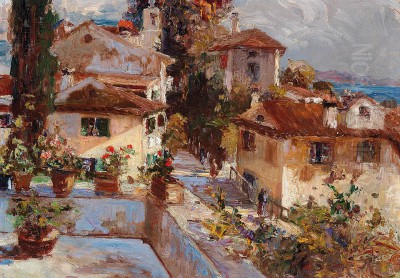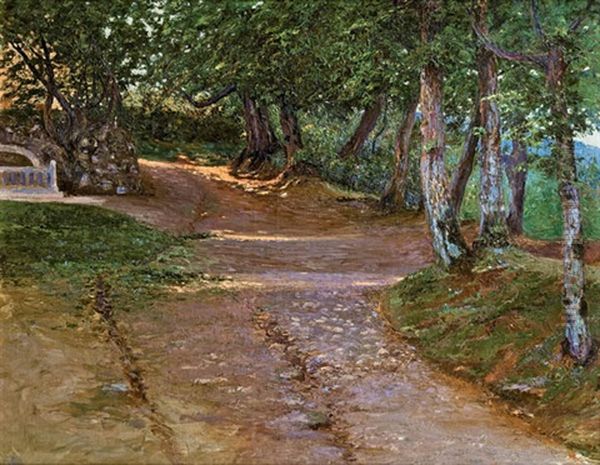
Leontine von Littrow, often known as Lea, stands as a significant figure in Austrian art history, particularly noted for her evocative depictions of marine landscapes and coastal scenes. Born in the mid-19th century, she navigated the challenges faced by female artists of her era, developing a distinct style influenced by Impressionism and leaving behind a body of work that captures the light and atmosphere of the Adriatic and Mediterranean coasts. Though her name faded into relative obscurity for a time after her death, recent scholarship and exhibitions have brought renewed attention to her contributions, revealing a talented painter deeply connected to the sea.
Early Life and an Influential Family
Leontine von Littrow was born on March 17, 1856, in Turin, Italy, into a distinguished Austrian noble family. Her background was steeped in intellectual and artistic pursuits. Her father, Heinrich von Littrow, was a notable figure, described as both a cartographer and astronomer, as well as serving as a frigate captain and harbour captain in the port of Rijeka (then Fiume), a key maritime city on the Croatian coast under Austrian rule. This connection to the sea through her father's profession undoubtedly played a formative role in her later artistic focus.
Her mother, Auguste von Littrow (née Bischoff), was also a prominent figure, known as a publisher and an advocate for women's rights, contributing to the progressive atmosphere within the household. The Littrow family boasted other luminaries; her uncle, Karl Ludwig von Littrow, was a celebrated astronomer, succeeding his own father Joseph Johann von Littrow as director of the Vienna Observatory. Leontine's sister, Ella von Littrow, followed in her mother's footsteps as a feminist. Growing up in this environment, surrounded by science, art, literature, and progressive ideas, provided Leontine with a unique foundation, although much of her life was spent not in Vienna but along the Adriatic coast, primarily in Croatia.
Artistic Training and Parisian Influences

Recognizing her artistic inclinations, Leontine sought formal training, a path often difficult for women in the 19th century when many official academies barred female students. She travelled to Paris, the vibrant heart of the European art world and the birthplace of Impressionism, to pursue her education. There, she studied under Jean d'Alheim (sometimes referred to as Jean-Domenech), himself an Impressionist painter. This mentorship proved profoundly influential, shaping her approach to light, colour, and capturing fleeting moments.
The exposure to the Parisian art scene connected her directly to the revolutionary ideas of Impressionism, pioneered by artists like Claude Monet, Pierre-Auguste Renoir, and Edgar Degas. Like many female artists of her time, including the French painter Berthe Morisot and the American expatriate Mary Cassatt, Littrow faced societal and professional hurdles. To navigate the male-dominated exhibition world and increase the chances of her work being accepted, she adopted masculine or ambiguous pseudonyms early in her career, signing her works as "Leo Littrow" or simply "Lea Littrow." This practice highlights the systemic barriers women artists encountered in gaining recognition based purely on merit.
The Call of the Sea: Style and Subject Matter
Leontine von Littrow's artistic identity became inextricably linked with the sea. Her primary subjects were marine landscapes, coastal views, and harbour scenes. Drawing inspiration from her life on the Adriatic, she painted the bustling ports, the tranquil waters of Venetian canals, fishermen setting out in their boats, and the dramatic play of light on the waves. Her works often feature locations along the Austrian Riviera, the Dalmatian coast, and Italy, including areas in South Tyrol like Trento and Dubrovnik.
Her style reflects the lessons learned from Impressionism. She demonstrated a keen sensitivity to atmospheric effects, employing broken brushwork and a vibrant palette to capture the changing light and weather conditions of the coast. While clearly influenced by Impressionist techniques, some observers also note elements of Romanticism in the evocative moods and sometimes dramatic compositions of her seascapes. She earned the moniker "painter of the sea," a testament to her dedication and skill in this genre, distinguishing her work within the broader Austrian art landscape, which was often more focused on portraiture or Alpine scenery, though landscape painters like Emil Jakob Schindler were gaining prominence.
Signature Works and Notable Commissions
Among Leontine von Littrow's representative works, several stand out. Porta Cumae depicts the ancient gateway near Naples, Italy, blending historical ruins with the surrounding natural landscape, showcasing her ability to harmonize different elements within a composition. Another significant piece is Meeresbrandung (meaning Surf or Tidal Wave), an oil painting measuring approximately 48.5 x 68.5 cm. This work exemplifies her focus on the dynamic energy of the sea and likely captures the Adriatic coast she knew so well. Its importance is underscored by its appearance at auction houses like Dorotheum in Vienna, where it commanded significant estimates.
Beyond her easel paintings, Littrow received a unique commission that further highlights her specialization. She was involved in the decoration of the prestigious Vienna Natural History Museum (Naturhistorisches Museum Wien). Her contribution reportedly involved creating illustrations of marine life, a task perfectly suited to her expertise. Significantly, this project is noted as the only instance where she signed the work with her full, undisguised name, Leontine von Littrow, perhaps indicating a level of official acceptance or a context where her gender was not perceived as a barrier.
Recognition, Exhibitions, and Artistic Circles
During her lifetime, Leontine von Littrow achieved considerable recognition. Her paintings were exhibited in major European art centres, including Vienna, Munich, and London, where they received positive critical appraisal. This exposure placed her work before an international audience and integrated her into the broader currents of European art at the turn of the century. Her success demonstrates her ability to overcome, at least partially, the obstacles faced by women artists in gaining access to prominent exhibition venues.
In Vienna, she was connected to the city's vibrant artistic and intellectual life. She was a member of the Verein der Schriftstellerinnen und Künstlerinnen Wiens (Association of Viennese Women Artists and Writers), an important organization founded to support and promote female creativity in a male-dominated cultural sphere. This membership connected her with peers and provided a platform for mutual support and professional advancement. Her circle included friendships with other notable artists.
Friendships and Collaborations: Olga Wisinger-Florian
One of Leontine von Littrow's most significant professional relationships was her close friendship and collaboration with fellow Austrian artist Olga Wisinger-Florian. Wisinger-Florian was another prominent female painter associated with Austrian Stimmungsimpressionismus (Mood Impressionism), known for her landscapes and floral still lifes. She had studied with notable artists like Emil Jakob Schindler. The two women shared artistic sensibilities and likely supported each other in their careers.
Their connection extended to joint artistic creation. Sources mention a specific work, Südliche Parklandschaft (Southern Park Landscape), as a collaborative piece, demonstrating a remarkable level of mutual respect and shared vision. This collaboration underscores the supportive networks that women artists sometimes formed to navigate their professional lives. Littrow's engagement with contemporaries like Wisinger-Florian, and her place alongside other successful Austrian women landscape painters such as Tina Blau and Marie Egner, situates her firmly within a generation of female artists who asserted their presence in Austrian art. Other notable female contemporaries in the Viennese art scene included the sculptor Teresa Feodorowna Ries and the painter Broncia Koller-Pinell.
Later Years and Rediscovery
Leontine von Littrow spent her later years continuing to paint the coastal scenes she loved. She passed away on May 11, 1925, in Abbazia (modern-day Opatija, Croatia), a fashionable seaside resort on the Adriatic where she had spent much of her life. Despite the recognition she enjoyed during her career, her work, like that of many women artists of her generation, gradually faded from mainstream art historical narratives in the decades following her death.
However, the late 20th and early 21st centuries have seen a renewed scholarly and curatorial interest in rediscovering forgotten female artists. Leontine von Littrow has benefited significantly from this trend. A major milestone in her posthumous recognition was the publication of a comprehensive monograph on her life and work in 2017. This publication brought together extensive research and reproductions of her paintings, making her oeuvre accessible to a wider audience.
Furthermore, a significant retrospective exhibition dedicated to her work was held, reportedly also around 2017, at the City Museum of Rijeka in Croatia. This exhibition served to reintroduce her art to the public, particularly in the region that so profoundly shaped her artistic vision. These efforts have helped to restore Leontine von Littrow's reputation and secure her place within Austrian and European art history.
Legacy and Conclusion
Leontine von Littrow remains an important figure in Austrian art, particularly as a pioneering female artist who specialized in marine painting. Her life and career reflect both the opportunities and the constraints of her time. Born into privilege and a stimulating intellectual environment, she pursued formal artistic training and developed a distinctive Impressionist-influenced style focused on the sea she knew intimately from her life on the Adriatic coast.
Her paintings, characterized by their sensitivity to light, atmosphere, and the dynamic nature of the sea, stand comparison with other Austrian landscape painters of the era, such as Carl Moll or Theodor von Hörmann, who were also exploring modern approaches to capturing nature. While she used pseudonyms to navigate the art world, her talent earned her exhibitions in major cities and a lasting reputation cemented by commissions like the Vienna Natural History Museum project and collaborations with artists like Olga Wisinger-Florian.
The recent rediscovery of Leontine von Littrow's work enriches our understanding of Austrian Impressionism and the contributions of women artists to the cultural landscape of the late 19th and early 20th centuries. Her evocative seascapes continue to resonate, offering compelling visions of the Adriatic coast captured by a skilled and dedicated artist who truly deserves her title as a master of the sea.